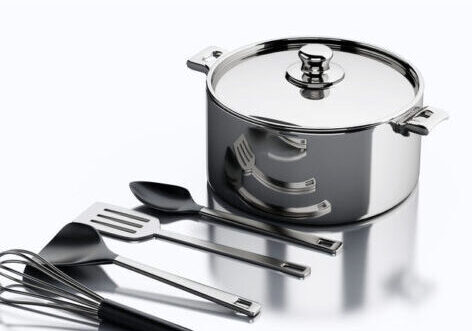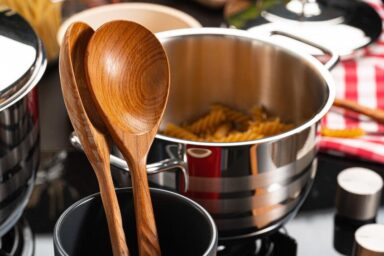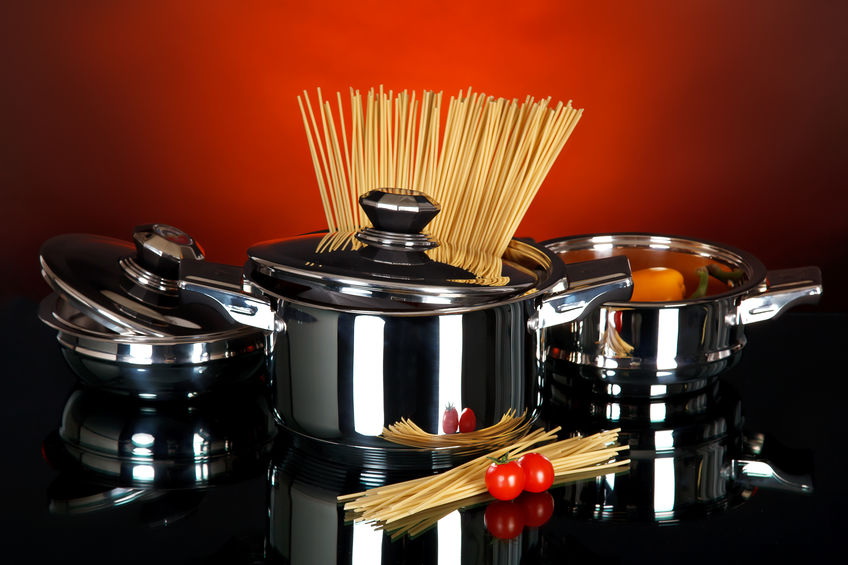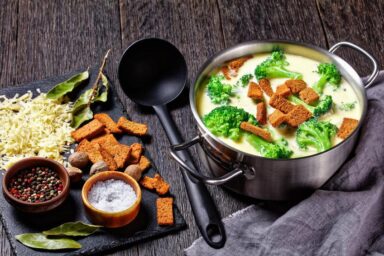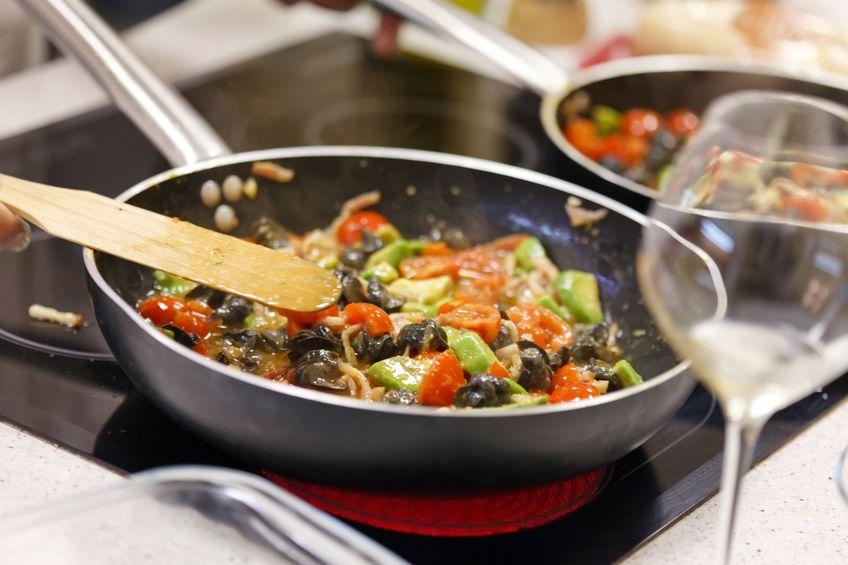
Cookware is an essential part of any kitchen, and having the right pots and pans can make a big difference in your cooking experience.
With so many different types of cookware available on the market, it can be challenging to know which one to choose.
In this article, we’ll introduce you to the various types of cookware and their unique features.
From stainless steel to non-stick, cast iron to copper, aluminum to ceramic, each type of cookware has its own benefits and drawbacks.
By understanding your options, you can make an informed decision and invest in cookware that will help you create delicious meals for years to come.
Stainless Steel Cookware – Durability and Versatility
Stainless steel cookware is one of the most popular options on the market, and for a good reason.
It is incredibly durable, versatile, and easy to maintain. Stainless steel cookware is made of a combination of metals, including iron, chromium, and nickel, which make it resistant to rust and corrosion.
One of the main benefits of stainless steel cookware is its durability.
It can withstand high heat, is resistant to scratches and dents, and doesn’t react with acidic or alkaline foods.
This means that stainless steel cookware can last for many years, making it a great investment for any home cook.
Stainless steel cookware is also very versatile. It can be used for a wide range of cooking techniques, from searing and frying to simmering and boiling. Stainless steel is also oven-safe and dishwasher-safe, making it easy to clean and care for.
While stainless steel is not non-stick, it does have a natural non-stick quality when it is heated properly.
This means that food can be easily released from the pan without sticking, as long as the pan is preheated and oiled properly.
Overall, stainless steel cookware is a reliable and practical option for any home cook.
It may be more expensive than some other types of cookware, but its durability and versatility make it a worthwhile investment.
Non-Stick Cookware – Convenience and Ease of Use
Non-stick cookware is a popular choice for many home cooks due to its convenience and ease of use.
This type of cookware has a special coating on the surface that prevents food from sticking, making it easier to cook and clean up.
One of the main benefits of non-stick cookware is its convenience.
With a non-stick surface, you don’t need to use as much oil or butter when cooking, making it a healthier option.
Food slides right off the pan, making it easy to flip and turn, and clean up is a breeze since there’s less food stuck to the surface.
Non-stick cookware is available in a variety of materials, including aluminum, stainless steel, and ceramic.
While non-stick coatings can wear off over time, some newer types of non-stick coatings, such as ceramic coatings, are more durable and longer-lasting.
One thing to keep in mind with non-stick cookware is that it’s not suitable for all types of cooking.
Non-stick coatings can’t handle high heat, so they’re not ideal for searing or frying at high temperatures.
Additionally, non-stick coatings can be damaged by metal utensils, so it’s best to use wooden or silicone utensils instead.
Overall, non-stick cookware is a great option for anyone looking for convenience and ease of use in the kitchen.
Just be sure to choose high-quality non-stick cookware, and take care not to overheat or use metal utensils on the surface.
Cast Iron Cookware – Traditional and Long-Lasting
Cast iron cookware is a traditional and long-lasting option for home cooks.
It is made by pouring molten iron into a sand mold, which gives it its characteristic weight and thickness.
One of the main benefits of cast iron cookware is its durability.
It can withstand high heat, is scratch-resistant, and doesn’t corrode easily.
Cast iron cookware can last for generations if it is cared for properly.
Another benefit of cast iron cookware is its ability to retain heat.
Once it’s heated, cast iron can maintain its temperature for a long time, making it ideal for slow-cooking or searing.
Cast iron cookware is also versatile and can be used for a variety of cooking methods, from baking to frying to grilling.
One of the unique features of cast iron cookware is that it can be seasoned to create a non-stick surface.
This is done by coating the surface with oil and heating it, which creates a polymerized layer that prevents food from sticking.
While cast iron cookware is heavy, it’s worth the extra effort to lift it. It can be used on all types of cooktops, including induction, and can be used in the oven or on the grill.
It also adds a rustic and traditional touch to the kitchen.
Overall, cast iron cookware is a durable and versatile option for any home cook.
It does require some maintenance, such as seasoning and careful cleaning, but with proper care, it can last for generations and become a beloved family heirloom.
Copper Cookware – Heat Conduction and Aesthetics
Copper cookware is a beautiful and efficient option for home cooks.
Copper is an excellent conductor of heat, which means that it heats up quickly and evenly.
Copper cookware is often used by professional chefs due to its precise temperature control.
One of the main benefits of copper cookware is its heat conductivity.
It responds quickly to changes in temperature, so you can cook food more evenly and precisely.
Copper cookware also distributes heat evenly across the surface, so you don’t have hot spots that can burn food.
Copper cookware is also beautiful and adds a touch of elegance to any kitchen.
It is often used for display purposes, as well as for cooking.
Copper cookware can be found in a variety of styles, from classic French designs to more modern shapes and colors.
One thing to keep in mind with copper cookware is that it requires more maintenance than some other types of cookware.
Copper can react with acidic foods, so it’s important to line the surface with another type of metal, such as stainless steel or tin.
Copper cookware can also tarnish over time, so it needs to be polished regularly to maintain its shine.
Overall, copper cookware is a high-quality and beautiful option for any home cook.
It’s an investment, as it can be more expensive than some other types of cookware, but its excellent heat conductivity and aesthetic appeal make it a worthwhile addition to any kitchen.
Aluminum Cookware – Lightweight and Affordable
Aluminum cookware is a lightweight and affordable option for home cooks.
It’s made of a lightweight metal that is easy to handle and heats up quickly.
One of the main benefits of aluminum cookware is its affordability.
It’s one of the most cost-effective materials used in cookware, making it accessible to a wide range of budgets.
Aluminum cookware is also lightweight, which makes it easy to handle and maneuver in the kitchen.
Aluminum cookware is also an excellent conductor of heat, so it heats up quickly and evenly.
It’s great for cooking foods that require high heat, such as stir-fries and seared meats.
Aluminum cookware can also be found with non-stick coatings, which makes it easier to cook and clean.
However, aluminum cookware has some drawbacks to consider.
It can react with acidic foods, which can cause a metallic taste and discoloration.
Aluminum cookware can also scratch easily, and it’s not as durable as some other types of cookware.
One thing to keep in mind with aluminum cookware is that it can be reactive with certain foods, such as acidic dishes like tomato sauce.
To avoid this, some aluminum cookware is coated with non-reactive materials like stainless steel or anodized aluminum.
Overall, aluminum cookware is a great choice for those on a budget or looking for lightweight options.
Just be sure to take care not to scratch or damage the surface, and consider coated options to avoid any reactivity with certain foods.
Ceramic Cookware – Non-Toxic and Eco-Friendly
Ceramic cookware is a non-toxic and eco-friendly option for home cooks.
It’s made of natural materials such as clay and sand, which makes it a safer and more sustainable alternative to traditional non-stick cookware.
One of the main benefits of ceramic cookware is its non-toxic nature.
Traditional non-stick cookware can release harmful chemicals when heated, but ceramic cookware is free from these chemicals.
It’s also non-reactive, which means it won’t alter the flavor of the food or leach metals into the food.
Ceramic cookware is also a good heat conductor, so it distributes heat evenly across the surface.
It’s great for slow cooking and retains heat well, making it ideal for stews, soups, and braises.
Ceramic cookware is also aesthetically pleasing, as it comes in a variety of colors and designs.
Another benefit of ceramic cookware is its durability.
It can withstand high temperatures, and it’s scratch-resistant.
However, it’s important to note that ceramic cookware can be fragile, and it’s not recommended to use metal utensils on the surface.
One potential drawback of ceramic cookware is that it can be heavy, which can make it difficult to handle.
It’s also not recommended to use it on high heat, as it can crack or become damaged.
Additionally, it can be more expensive than other types of cookware.
Overall, ceramic cookware is a great option for those looking for non-toxic and eco-friendly cookware.
It’s durable, non-reactive, and aesthetically pleasing. Just be sure to handle it with care and avoid high heat to avoid any potential damage.
Choosing the Right Cookware for Your Needs
When it comes to choosing the right cookware for your needs, there are a few factors to consider.
- Cooking needs. Consider the type of dishes you enjoy cooking and the cooking techniques you use. If you enjoy high-heat cooking, then stainless steel or cast iron may be a good choice. If you prefer non-stick surfaces for easy cleaning, then non-stick or ceramic cookware may be a better option.
- Material. Each material has its own benefits and drawbacks, as outlined above. Consider the heat conductivity, durability, and maintenance required for each material before making a decision.
- Budget. Cookware can range in price from very affordable to very expensive. Consider your budget and how much you are willing to spend before making a decision.
- Size. Cookware comes in a variety of sizes, so consider the size that is most appropriate for your needs. Consider the size of your stovetop burners, your storage space, and the size of the dishes you typically cook.
- Cooktop compatibility. Some cookware materials are not compatible with certain cooktops, such as induction cooktops. Be sure to check the compatibility of the cookware with your cooktop before making a purchase.
- Maintenance. Consider the maintenance required for each type of cookware. Some materials require special cleaning methods or seasoning, while others can be washed in a dishwasher. Choose a type of cookware that is easy to maintain and fits with your lifestyle.
Ultimately, the right cookware for you depends on your personal preferences, cooking needs, and budget.
Consider the factors above and choose the cookware that best suits your needs.
Caring for Your Cookware – Maintenance and Cleaning Tips
Proper maintenance and cleaning of your cookware are essential to extend its lifespan and ensure that it performs well. Here are some tips to help you care for your cookware:
- Read the manufacturer’s instructions. Before using your cookware, read the manufacturer’s instructions to understand how to care for it properly. Follow the instructions for cleaning, seasoning, and storage.
- Use the right utensils. Use utensils that are safe for your cookware. Avoid using metal utensils on non-stick surfaces, as they can scratch and damage the coating.
- Season your cast iron cookware. Cast iron cookware requires seasoning to prevent rust and maintain its non-stick surface. Follow the manufacturer’s instructions for seasoning, or use a thin layer of oil to coat the surface.
- Use the right cleaning tools. Avoid using harsh or abrasive cleaning tools on your cookware, as they can damage the surface. Use soft sponges or brushes to clean your cookware, and avoid using steel wool or scouring pads.
- Clean your cookware promptly. Clean your cookware promptly after use to prevent food from sticking or staining the surface. Use warm water and mild soap to clean your cookware, and dry it thoroughly with a soft cloth.
- Store your cookware properly. Store your cookware in a dry, cool place. Avoid stacking heavy items on top of each other, as this can damage the surface.
- Avoid extreme temperatures. Avoid exposing your cookware to extreme temperatures, as this can damage the surface. For example, do not put a hot pan in cold water or use it on high heat if it’s not designed for high heat.
By following these tips, you can maintain and extend the lifespan of your cookware, ensuring that it performs well for years to come.
Enhancing Your Culinary Experience with the Right Cookware
Investing in the right cookware can enhance your culinary experience and make cooking more enjoyable.
By understanding the different types of cookware available and the benefits of each material, you can choose the cookware that best suits your needs and cooking style.
Stainless steel cookware is durable and versatile, while non-stick cookware offers convenience and ease of use.
Cast iron cookware is traditional and long-lasting, and copper cookware is prized for its heat conductivity and aesthetics.
Aluminum cookware is lightweight and affordable, while ceramic cookware is non-toxic and eco-friendly.
When choosing the right cookware for your needs, consider factors such as your cooking needs, material, budget, size, cooktop compatibility, and maintenance requirements.
By caring for your cookware properly, you can extend its lifespan and ensure that it performs well.
Investing in high-quality cookware can elevate your cooking skills and make your time in the kitchen more enjoyable.
With the right cookware, you can create delicious meals with ease and confidence.
